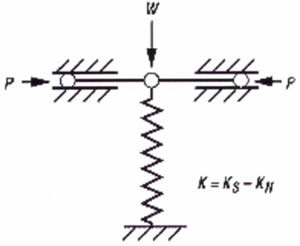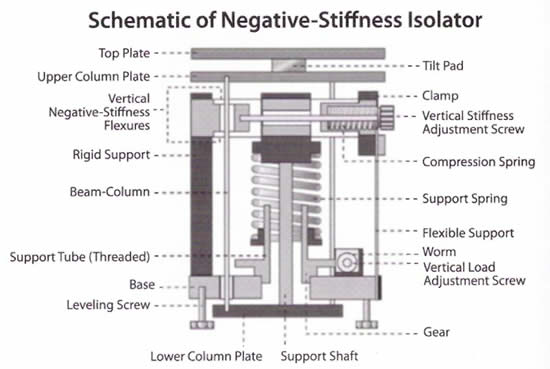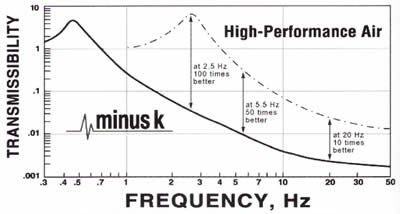
Microsopy Today - May 2009
Vibration Isolation Critical to Measuring Neuronal Patterns in the Brain
David L. Platus
Minus K Technology, Inc., Inglewood, California
sales@minusk.com
Researchers at Georgetown University's Department of Physiology
and Biophysics use negative-stiffness vibration isolators
to help measure micron-level patterns of neuronal activity
in the mammalian neocortex. The research is shedding new light
into brain sensory and motor processing functions relating
to cardiac fibrillation and epilepsy.
Isolating a laboratory's sensitive microscopy equipment against
low-frequency vibration has become increasingly more vital
to maintaining imaging quality and data integrity for neurobiology
researches. Ever more frequently, laboratory researchers are
discovering that conventional air tables and the more recent
active (electronic) vibration isolation systems are not able
to adequately cancel out the lower frequency perturbations
derived from air conditioning systems, outside vehicular movements
and ambulatory personnel. Such was the case with the Department
of Physiology and Biophysics at Georgetown University Medical
Center, where Professor Jian-Young Wu has been conducting
research on waves of neuronal activity in the neocortex of
the brain.
Propagating Waves in Neocortical Slices
Wu and his colleagues visualize wave-like patterns in the
brain cortex using a new method called voltage-sensitive dye
imaging. They use a special dye that binds to the membrane
of neurons and changes color when electrical potential changes
on the membrane of active neurons. The neuronal sample is
derived from slices of rat neocortex.
The neocortex is the outer layer of
the cerebral hemispheres in the brain of mammals. Made
up of six layers, it is involved in higher functions such
as sensory perception, generation of motor commands and,
in humans, language. The neurons of the neocortex are
arranged in vertical structures called neocortical columns.
These are patches of the neocortex with a diameter of
about 0.5 mm and a depth of 2 mm. Each column typically
responds to a sensory stimulus representing a certain
body part, or region of sound or vision. In the human
neocortex, it is postulated that there are about a half-million
of these columns, each of which contains approximately
60,000 neurons.
 The neocortex can be viewed as a huge web, consisting
of billions to trillions of neurons and hundred of trillions
of interconnections. While individual neurons are too
simple to have intelligence, the collective behavior of
the billions of interneuronal interactions occurring each
second can be highly intelligent.
The neocortex can be viewed as a huge web, consisting
of billions to trillions of neurons and hundred of trillions
of interconnections. While individual neurons are too
simple to have intelligence, the collective behavior of
the billions of interneuronal interactions occurring each
second can be highly intelligent.
Traditionally, scientists have studied brain activity by placing
a few electrodes in the brain and measuring the electrical
signals of the neurons close to the electrodes. This method
is workable for understanding the function of the cortex and
interactions between individual neurons, but it is not suitable
for studying the emerging properties of the nervous system.
It is like viewing a few pixels on a television screen and
trying to figure out the story. Now, with optical methods
and voltage-sensitive dyes, Georgetown University researchers
can visualize the activation in a large area of the neocortex
when the brain is processing sensory information, similar
to watching the whole television screen.
Voltage-sensitive dye is a compound that stains neuronal membrane
and changes its color when the neuron is excited. This allows
Wu to visualize population neuronal activity dynamically in
the cortex and study how individual neurons in the neocortex
interact to generate population neuronal activities that underlie
sensory and motor processing functions. Population activities
are composed of the coordinated activity of up to billions
of neurons. Currently, his team studies how oscillations and
propagating waves can be generated by small ensembles of neocortical
neurons.
Viewing the spatiotemporal patterns of neuronal population
in the cortex is markedly different from recording individual
neurons. Here the cortical activity is viewed as "population
activity," that can be more complex than the linear addition
of an individual neurons activity. Voltage-sensitive dye and
optical recording techniques give the neuroscientist a new
tool for figuring out how the brain cortex works.

Spiraling Waves in the Brain Shed Light
on Cardiac Fibrillation and Epilepsy
The Georgetown imaging team has uncovered spiraling wave patterns
resembling little hurricanes in the brain. He believes that
this hurricane-like spiral pattern is an emergent behavior
of the network. Just as a metrological hurricane is an emergent
behavior of a large volume of air molecules, if you were to
dissect a hurricane into individual air molecules you would
not find any special process that generates a hurricane. Similarly,
the Georgetown team has found that in the nervous system,
spiral waves are an emergent process of the neuronal population
and there might be no special cellular process attributed
to spirals. But like a hurricane, spiral waves can be a powerful
force for organizing the activity of a neuronal population.
Spirals generated in a small area can send out a powerful
storm that invades large, normal brain areas and starts a
seizure attack. This hypothesis would mean that epilepsy could
be viewed not just as a miswiring in the brain, but as an
abnormal wave pattern that invades normal tissue.
Likewise, during cardiac fibrillation, spiral waves form in
the heart emitting rotating and scroll waves in two and three
dimensions. As a leading life-threatening situation, these
rotating waves can kill the patient instantly as the pumping
function of the heart is disrupted by the 5 to l0 Hz rotations
that drives chaotic and abnormally rapid cardiac contractions.
Wu believes that propagating waves are a basic pattern of
cortical neuronal activity, and that these wave patterns may
play an important role in initiating and organizing brain
activity involving millions to billions of neurons. Studying
the spatiotemporal patterns of neuronal population activity
may provide insight into normal brain functions and pathological
disorders. This research has the potential to help scientists
understand abnormal waves that are generated in the brains
of patients with epilepsy.
Vibration Isolation
Since voltage-sensitive dye signals are small, usually a change
of 0.l to 1.0 percent of the illumination intensity, the Georgetown
team has used a high-dynamic-range camera, photodiode array
to detect the voltage-sensitive dye signals of the cortical
activity. The photodiode array can resolve extremely small
changes in light, usually one part of ten thousands. (Human
eyes and ordinary digital cameras register light changes of
one part to a hundred). Detecting such small signals requires
an extreme isolation of vibration. The lab had to contend
with low frequency vibrations from air conditioning equipment,
people walking, and wind blowing against the building. Vibrations
as low as 1 Hz were inhibiting the integrity of the images
and data.
 Figure 1 A vertical-motion isolator,
as demonstrated in figure I, uses a conventional spring
connected to an NSM consisting of two bars hinged at
the center, supported at their outer ends on pivots,
and loaded in compression by forces P. (The hinged bars
are for illustration only. Flexures are used in the
isolators to avoid stiction and friction.) The spring
is compressed by weight W to the operating position
of the isolator. The stiffness of the isolator is K=Ks-KN
where Ks is the spring stiffness and KN is the magnitude
of a negative stiffness which is a function of the length
of the bars and the load P. The isolator stiffness can
be made to approach zero while the spring supports the
weight W.
Figure 1 A vertical-motion isolator,
as demonstrated in figure I, uses a conventional spring
connected to an NSM consisting of two bars hinged at
the center, supported at their outer ends on pivots,
and loaded in compression by forces P. (The hinged bars
are for illustration only. Flexures are used in the
isolators to avoid stiction and friction.) The spring
is compressed by weight W to the operating position
of the isolator. The stiffness of the isolator is K=Ks-KN
where Ks is the spring stiffness and KN is the magnitude
of a negative stiffness which is a function of the length
of the bars and the load P. The isolator stiffness can
be made to approach zero while the spring supports the
weight W.
At first, high-quality air tables were utilized, but they
were not adequate for isolating low frequency vibrations.
They then tried putting a second air table on top of the first
one, but that still did not give them the isolation needed.
Then they tried an active, electronic system, but were still
spending much time fighting with floor vibrations. Effectively,
the lab was dealing with an unresolved vibration problem for
many years.
The Georgetown lab eventually tested, and settled upon negative-stiffness
mechanism vibration isolation systems from Minus K Technology,
which enabled the lab to get vibration isolation down to a
level of 1 Hz. This effectively cancelled out any vibration
noise difficulties that were inhibiting image and data readings.
[1.-4.]

Figure 2 A horizontal-motion isolation system, as demonstrated in figure 2, is illustrated by two beam-column isolators. Each isolator behaves like two fixed-free beam-columns loaded axially by a weight load W. Without the weight load the beam-columns have horizontal stiffness Ks. With the weight load the lateral bending stiffness is reduced by the "beam-column" effect. This behavior is equivalent to a horizontal spring combined with an NSM so that the horizontal stiffness is K-Ks-KN, and KN is the magnitude of the beam-column effect. Horizontal stiffness can be made to approach zero by loading the beam-columns to approach their critical buckling load.
Negative-stiffness mechanism (NSM) isolators have the flexibility of custom tailoring resonant frequencies vertically and horizontally. They employ a completely mechanical concept in low-frequency vibration isolation. Vertical motion isolation is provided by a stiff spring that supports a weight load, combined with a NSM. The net vertical stiffness is made very low without affecting the static load-supporting capability of the spring

Figure 3 Schematic of a NSM vibration
isolator, as shown in figure 3. A vertical stiffness
adjustment screw is used to regulate the compression
force on the negative-stiffness flexures. A vertical
load adjustment screw raises or lowers the base of the
support spring in response to varying weight loads to
keep the flexures in their straight, unbent operating
position.
Beam-columns connected in series with the vertical-motion isolator provide horizontal-motion isolation. The horizontal stiffness of the beam-columns is reduced by the "beam-column" effect. A beam-column behaves as a spring combined with a NSM. The result is a compact passive isolator capable of very low vertical and horizontal natural frequencies and very high internal structural frequencies.
 The transmissibility of a passive
negative-stiffness vibration isolator as shown in figure
4, me vibration that transmits through the isolator as
measured as a function of input vibrations - can be 10X
to l00X better air tables depending on the vibration frequency
The transmissibility of a passive
negative-stiffness vibration isolator as shown in figure
4, me vibration that transmits through the isolator as
measured as a function of input vibrations - can be 10X
to l00X better air tables depending on the vibration frequency
Transmissibility with negative-stiffness is substantially improved over air systems, which can make vibration isolation problems worse since they have a resonant frequency that can match that of floor vibrations. Transmissibility is a measure of the vibrations that transmit through the isolator relative to the input vibrations. The NSM isolators, when adjusted to 0.5 Hz, achieve 93 percent isolation efficiency at 2 Hz; 99 percent at 5 Hz; and 99.7 percent at l0 Hz.
 The Minus K BM-8 bench-top vibration
isolation platform is low-profile at 4.6 inches tall,
does not require air or electricity, and is portable and
user-friendly.
The Minus K BM-8 bench-top vibration
isolation platform is low-profile at 4.6 inches tall,
does not require air or electricity, and is portable and
user-friendly.
NSM transmissibility is also improved over active systems.
Because they run on electricity, active systems can be negatively
influenced by problems of electronic dysfunction and power
modulations, which can interrupt scanning. They also have
a limited dynamic range - which is easy to exceed - causing
the isolator to go into positive feedback and generate noise
underneath the equipment. Although active isolation systems
have fundamentally no resonance, their transmissibility does
not roll off as fast as negative-stiffness isolators.
Continuing Research
Within the past ten years, Dr.Wu's team has documented a variety
of waveforms (e.g., plane wave and spirals) in brain slices
during artificially induced oscillations. Using neocortical
slices and mathematical models, they are studying the initiation
of the waves and the factors that control their propagating
direction and velocity.
The lab is also involved in the development of new optical
imaging techniques - relying on the negative-stiffness vibration
isolation systems - such as imaging propagating waves in vivo,
in intact brains, which is technically difficult because other
imaging methods (MRI, PET or MEG) provide inadequate spatiotemporal
resolution. Large-scale neuronal activity is a hallmark of
a living brain. Wu's team is improving the optical imaging
techniques with a hope to visualize the waves in the cortex
in vivo during sensory processes and in awake animals while
behavioral and cognitive tasks are performed.
References:
1.
David K. Ferry, Ph.D., Negative-Stiffness Vibration Isolation
Improves Reliability of Nanoinstrumentation, Laser Focus World,
October, 2007,
2. L.B. Cohen, More Than Just Floating on Air, BioPhototonics.
International, March 2008.
3. Jim McMahon, Vibration Isolation in Cleanrooms, Controlled
Environments, January 2008.
4. P. O'Hara, Mechanical Isolators Stop the Shakes, Design
News, March 2007.